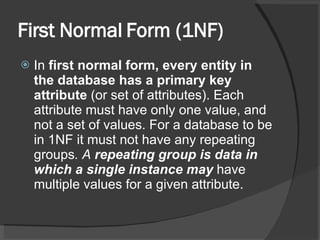b - Normalizing a Data Model
- 1. Instructor : Dimara Kusuma Hakim, ST.
- 2. What Is Normalization? At its most basic level, normalization is the process of simplifying your data into its most efficient form by eliminating redundant data. Efficiency, in this case, refers to reducing complexity from a logical standpoint. Efficiency does not necessarily equal better performance, nor does it necessarily equate to efficient query processing.
- 3. Normal Forms E. F. Codd, who was the IBM researcher credited with the creation and evolution of the relational database, set forth a set of rules that define how data should be organized in a relational database. Initially, he proposed three sequential forms to classify data in a database: first normal form (1NF) second normal form (2NF) third normal form (3NF).
- 4. Normal Forms …cont… After these initial normal forms were developed, research indicated that they could result in update anomalies, so three additional forms were developed to deal with these issues: fourth normal form (4NF), fifth normal form (5NF), and the Boyce-Codd normal form (BCNF). There has been research into a sixth normal form (6NF); this normal form has to do with temporal databases and is outside the scope of this discussion.
- 5. First Normal Form (1NF) In first normal form, every entity in the database has a primary key attribute (or set of attributes). Each attribute must have only one value, and not a set of values. For a database to be in 1NF it must not have any repeating groups . A repeating group is data in which a single instance may have multiple values for a given attribute.
- 6. 1NF … cont… example repeating group !
- 7. Wrong way !
- 8. The Right Way
- 9. We’ve solved the problem by adding another entity that stores album names as well the attribute that represents the relationship to the artist entity. Neither of these entities has a repeating group, each attribute in both entities holds a single value, and all of the previously mentioned query problems have been eliminated.
- 10. Second Normal Form (2NF) Second normal form (2NF) specifies that, in addition to meeting 1NF, all non-key attributes have a functional dependency on the entire primary key. A functional dependency is a one-way relationship between the primary key attribute (or attributes) and all other non-key attributes in the same entity.
- 13. Third Normal Form (3NF) Third normal form is the form that most well-designed databases meet. 3NF extends 2NF to include the elimination of transitive dependencies. Transitive dependencies are dependencies that arise from a non-key attribute relying on another non-key attribute that relies on the primary key. In other words, if there is an attribute that doesn’t rely on the primary key but does rely on another attribute, then the first attribute has a transitive dependency.
- 14. The differences between 2NF and 3NF are very subtle. 2NF deals with partial dependency, and 3NF with transitive dependency. A Partial Dependency means that attributes in the entity don’t rely entirely on the primary key. Transitive Dependency means that attributes in the entity don’t rely on the primary key at all, but they do rely on another non-key attribute in the table. In either case, removing the offending attribute (and related attributes, in the 3NF case) to another entity solves the problem.
- 15. NORMALIZATION VS. DENORMALIZATION Normalization means reducing duplicate data by using keys or IDs to relate rows of information from one table to another, for example, customers and their orders. Denormalization means the opposite, which is deliberately duplicating data in one or more structures.
- 16. Cont…. NORMALIZATION VS. DENORMALIZATION Normalization improves the efficiency of inserting, updating, or deleting data. The fewer places the data has to be updated, the more efficient the update and the greater the data integrity. Denormalization improves the efficiency of reading or selecting data and reduces the number of tables the data engine has to access or the number of calculations it has to perform to provide information.
















